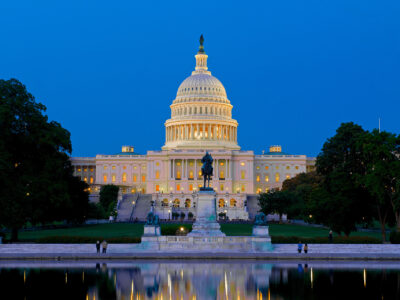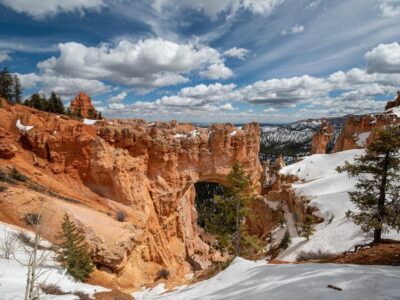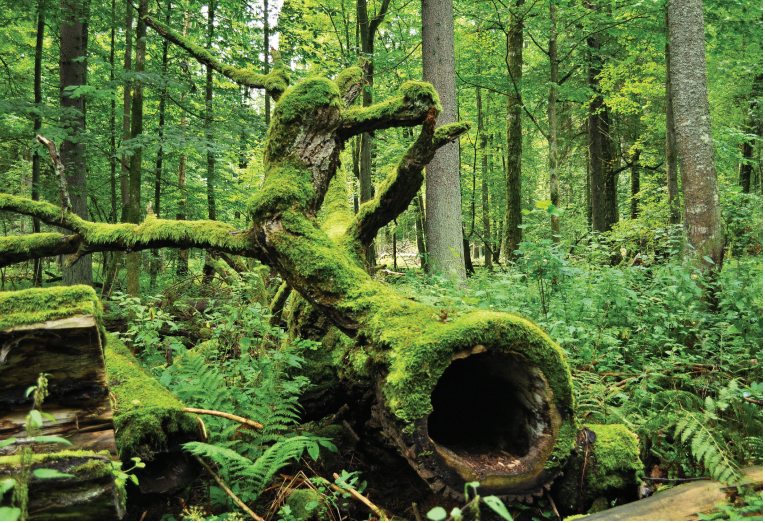
An old mossy trunk in Bialowieza forest
This forest has no equivalent in Europe. For over 8,000 years now, a large part of it has remained a primeval forest, untouched by man. Bialowieza stretches over 120,000 hectares: 56,500 hectares in the eastern part of Poland and 63,500 in the neighbouring Belarus. Since 1977, it is officially a part of the World Biosphere Heritage listed by UNESCO (United Nations Educational, Scientific and cultural Organization).
The natural environment harbours around 5,000 species of plants and trees – deciduous to coniferous and 12,000 species of animals. The forest is famous especially for its wild bison (about 300 of them still graze there freely in the Polish part) and for its predators, such as lynx and wolves, placed under special and vigilant protection.
Here, like in a jungle, nature dictates its rules. If one comes to Bialowieza (‘The white tower’ in Polish) in summer, which is a good season to discover Poland and the forest, the adventure usually begins in the early morning before the heat spreads into the forest.
Once the monumental wooden gate of the nature reserve has been crossed, one has to observe a moment of silence and listen to the noises of the forest, as a sign of respect and to mark the entry in a new world, where man, for once, is not the ruler but only a guest. Then, one can walk, or even take a bike for a while, to sink into small alleys surrounded by large deciduous trees, often multicentenary ones. They are the silent guardians of the place.
At each stop, one makes a new discovery, slightly off the marked trail, and admires for instance the mossy trunk of what was once a majestic oak. One of them is particularly famous. It fell during a storm in the 1960s and was called the “Jagiello Oak” because the legend says that in the 15th century Wladyslaw Jagiello, King of Poland, had rested under this tree. Some trees are almost 500 years old, however, in this primeval forest, where by definition man does not intervene in the course of nature; other trees are ready to take over. For instance, new branches have already adorned the sides of the “Jagiello Oak.”
Later while taking a stroll in dense undergrowth, one notices small oak struggling to acquire a place alongside his elders. Here, in this dense forest, each tree struggles to survive and reach the top. This fight in the green cathedral makes the trees vigorous and some of them can reach unparalleled dimensions – one hundred metres high for example for a spruce, or two meters in diameter for an oak.
Few human beings
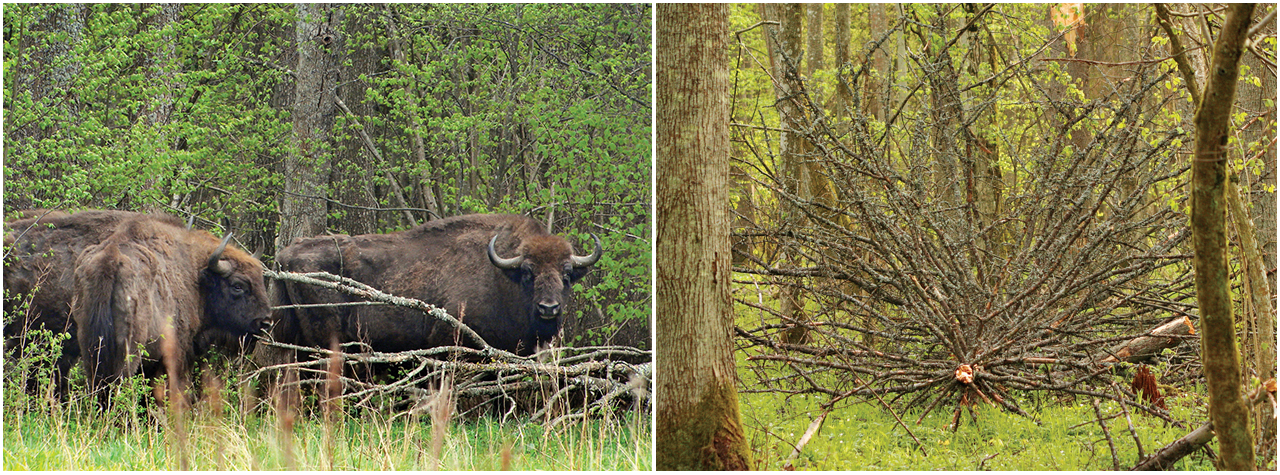
(Left to Right) European Bisons in the wild in Bialowieza; Man does leave trees live their natural cycle there, from birth to death
All the walker’s senses are awakened in this wild world. Sometimes, with eyes closed, one can deeply breathe the powerful and changing scents of the undergrowth that give the sensation of sweet fragrance during the summer.
The colours are a feast for the eyes. In summer, green is the king in an infinite variety of shades. In Spring, when the leaves do not yet completely cover the trees, the sun heats the dense growth and unleashes an ephemeral carpet of red flowers.
Sinking deeper into the reserve, deciduous trees give way to conifers. And at the end, a peaceful river brings a melodious respite to the patient trekker. It is rare to encounter human beings in this unspoilt Bialowieza reserve. Sometimes, one meets a small group of tourists accompanied by a guide, or some scientists conducting surveys or locating wild animals with transmitters for data collecting purposes. Usually these people at work are calm and speak softly, as if not to disturb the natural green coat surrounding them.
With a bit of luck after walking a few kilometres one will see at a distance, a bison or other wild animals. But sometimes, one will just be happy with the spectacle of trees and birds. Large animals often keep their distance and there is of course no right to disturb them, as happened in an unfortunate incident in the recent past.
If one really wants to see bison without too much effort, the “Bison Sanctuary”, a few kilometres from the nature reserve is the place to be. But this is actually a zoo, where elks, wild boars and various “zubroń”, a crossing between a bison and a cow, are kept safely.
It is far more enjoyable to stay in the reserve and patiently accept wild nature’s order where wild animals such as bison enjoy the right to remain hidden. But one should not stay put to enjoy Bialowieza and its surroundings because mankind’s unfaltering craving for the wildlife could threaten its natural balance in the near future.
On the Belarusian side of Bialowieza, the primeval forest is very well protected and hunting is controlled. But on the Polish side, only 16 pc of the forest area is classified as a national park and protected as such. And less than 8 pc of it is strictly monitored as a nature reserve part. Biologists fear that the rest of this fantastic heritage may gradually disappear in the Polish area.
Large portions of Bialowieza forest are indeed intensely exploited by the national forest public body, in partnership with small local sawmills businesses. The oldest trees are the most threatened because they are also unfortunately the most valuable ones: they can be 20 times more expensive than a sapling. Another threat to wild nature comes from poachers who notably target wolves.
Faced with these economic interests, conservationists, supported by numerous personalities and artists claim that the entire Bialowieza forest should become a national park. Preserving it while there’s still time and developing a reasoned tourism beyond the hundreds and thousands of nature lovers who already throng the Bialowieza every year, should be the natural course to follow.
Kings, tsars and Rousseau
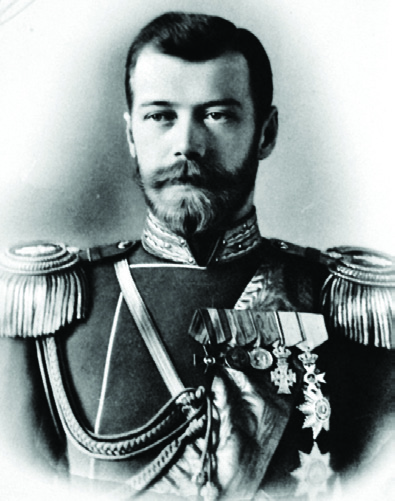
Nicolas II, last Russian Tsar and a famous hunter
It’s a miracle if the Bialowieza forest has retained some of its primeval authenticity and freshness because men have tried for centuries to invade and exploit the forest. Long inaccessible, this “Puszcza Bialowieska” (“Bialowieza forest” in Polish) became in the 15th century the private hunting ground of Polish monarchs. It is said that Polish King Wladyslaw Jagiello came here to hunt in 1410, just before his victorious battle against the Teutonic Knights, a landmark in Polish history.
After the partition of Poland between Prussia, Russia and Austria-Hungary in the 19th century, it was the Russian Tsars who came to Bialowieza for hunting game. In the Museum of Bialowieza National Park, one can thus admire the hunting record, some magnificent bison, of the last Tsar, Nicolas II. He was few years later swept away by the two Russian revolutions in 1917, which led to the victory of Lenin and the communists.
During the First World War, the Germans exploited the forest excessively. They cut more than five million cubic metres of wood, threatening wildlife’s equilibrium. After such a disaster, when Poland recovered its independence, part of the forest was declared a protected reserve and in 1932 was into a natural park, the largest of its kind in Europe.
Two years prior, wild bison had been reintroduced into the forest. These biggest mammals in Europe that sometimes weigh more than a ton, had disappeared from Bialowieza forest just after the First World War. Fortunately, some specimens had remained in Polish zoos and they were reacclimated to their natural habitat.
During the Second World War, the population of Bialowieza has suffered massacres inflicted by the Nazis and the Soviets, as evident by the small crosses at the entrance of the nature reserve.
In 1945, the survivors found themselves almost entirely under Soviet control, as Russians were occupying Poland. But Soviet leader Stalin finally abandoned the idea to annex the whole Bialowieza region. The forest was shared between Poland and Belarus, then a republic of the Soviet Union (USSR). Ironically, in this same forest, on the Belarusian side, Boris Yeltsin, the leader of Russia at that time, came to sign the ‘death certificate’ of the Soviet Union in 1991. During this long and turbulent history, the population of the Bialowieza region has been forced to learn to live with many people and different religions. Bialowieza people were always on the border of several influences and long isolated in the great forest.
Poles, Russians, Belarussians and Germans have played leading roles in this part of Central and Eastern Europe. But the French came close to send to Bialowieza one of their greatest philosophers of the Enlightenment movement, Jean-Jacques Rousseau (1712-1778). He had to go and meditate in the forest at the invitation of the Royal Reserve administrator. But Rousseau became angry with Poland. It is said that in Paris, a Pole had borrowed a tidy sum of money from Rousseau and never returned it. Angered, the philosopher decided not to come to Bialowieza, which could have inspired for sure this great nature lover.










